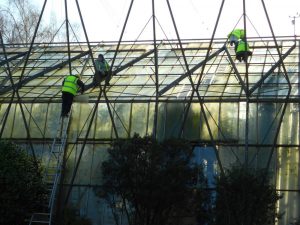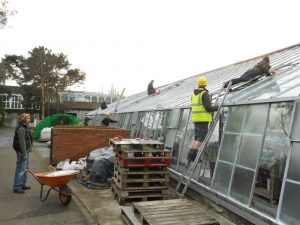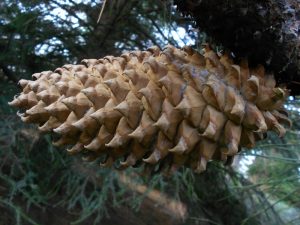“The worst storm for a decade” said the weather forecaster following a day of violent winds and heavy rain. Wind speeds in excess of 100mph were recorded in Edinburgh on Tuesday 3rd January. We returned from the New Year break to a Garden devastated by the storm. Prior to this the worst damage the Garden experienced was during the Boxing Day storm of 1998. Tuesday’s damage far exceeded the devastation caused 14 years ago. We have recorded 34 trees as dead and in addition noted damage to a further 40 trees. Many were uprooted including historic collections by Joseph Rock and Ernest Wilson; others have had their canopy twisted from the trunk, being deposited some distance away on other trees and shrubs causing collateral damage. The loss of mature trees reduces the age class of the living collection and the maturity of the Garden. A dismal sight to start the year but this opening up of canopy space does create planting opportunities. The fabric of the garden also suffered. The chimney stack on the former laundry building adjacent to Inverleith House was caught by the limb of X Cupressocyparis leylandii as it parted company from the main trunk smashing masonry as it collided with the building.
Glasshouses, not known for their flexibility, arched and buckled in the storm. As a consequence upwards of 600 panes of glass were lost. Many flying considerable distances causing alarm and further damage at their final resting place. The Garden remained closed on Wednesday 4th January while the initial clean up operation commenced. Drawing on the combined skills of the horticultural team the work progressed steadily with concerted effort put into opening up the roads and pathways blocked by fallen timber. Reglazing the tropical glasshouses was also of paramount importance. The holes left by the damaged glass means the required temperature levels cannot be reached and with lower temperatures forecast the need for cover is essential. The supply chain then becomes important as although we keep a quantity of spare glass nothing like the quantity required to repair this damage. The nature of the wholesale destruction means it will be a while before order is restored. The weather deteriorated again overnight of the 4th January with high winds and torrential rain; 10.4mm of rain falling in the 24hours to 10.00am Thursday 5th January.
One of the casualties was Pinus coulteri, a magnificent specimen, (meriting a mention by WJ Bean in Trees and Shrubs Hardy in the British Isles), on the west boundary, that twisted apart from the trunk at a height of 20 metres. This tree produces large cones not often seen close up. These disappeared from the fallen remains like snow off a dyke once people realised how accessible they then were. Introduced from California by David Douglas in 1832, this species has the largest cones of the genus. It is often termed “the widow maker” as the weight of a cone dropping from height can cause considerable damage. P. coulteri was named after Thomas Coulter an Irish physician who founded and then became Director of the Herbarium at Trinity College, Dublin. He also travelled to Mexico from where he made botanical excursions to the southern states of the USA. Hence his relationship with the species.



